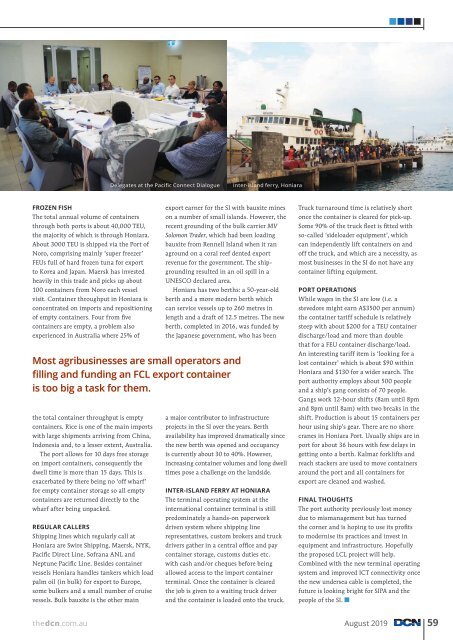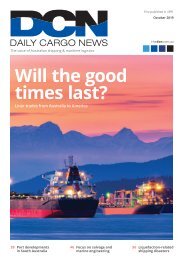DCN AUGUST Edition 2019
You also want an ePaper? Increase the reach of your titles
YUMPU automatically turns print PDFs into web optimized ePapers that Google loves.
Delegates at the Pacific Connect Dialogue<br />
Inter-island ferry, Honiara<br />
FROZEN FISH<br />
The total annual volume of containers<br />
through both ports is about 40,000 TEU,<br />
the majority of which is through Honiara.<br />
About 3000 TEU is shipped via the Port of<br />
Noro, comprising mainly ‘super freezer’<br />
FEUs full of hard frozen tuna for export<br />
to Korea and Japan. Maersk has invested<br />
heavily in this trade and picks up about<br />
100 containers from Noro each vessel<br />
visit. Container throughput in Honiara is<br />
concentrated on imports and repositioning<br />
of empty containers. Four from five<br />
containers are empty, a problem also<br />
experienced in Australia where 25% of<br />
the total container throughput is empty<br />
containers. Rice is one of the main imports<br />
with large shipments arriving from China,<br />
Indonesia and, to a lesser extent, Australia.<br />
The port allows for 10 days free storage<br />
on import containers, consequently the<br />
dwell time is more than 15 days. This is<br />
exacerbated by there being no ‘off wharf’<br />
for empty container storage so all empty<br />
containers are returned directly to the<br />
wharf after being unpacked.<br />
REGULAR CALLERS<br />
Shipping lines which regularly call at<br />
Honiara are Swire Shipping, Maersk, NYK,<br />
Pacific Direct Line, Sofrana ANL and<br />
Neptune Pacific Line. Besides container<br />
vessels Honiara handles tankers which load<br />
palm oil (in bulk) for export to Europe,<br />
some bulkers and a small number of cruise<br />
vessels. Bulk bauxite is the other main<br />
export earner for the SI with bauxite mines<br />
on a number of small islands. However, the<br />
recent grounding of the bulk carrier MV<br />
Solomon Trader, which had been loading<br />
bauxite from Rennell Island when it ran<br />
aground on a coral reef dented export<br />
revenue for the government. The shipgrounding<br />
resulted in an oil spill in a<br />
UNESCO declared area.<br />
Honiara has two berths: a 50-year-old<br />
berth and a more modern berth which<br />
can service vessels up to 260 metres in<br />
length and a draft of 12.5 metres. The new<br />
berth, completed in 2016, was funded by<br />
the Japanese government, who has been<br />
Most agribusinesses are small operators and<br />
filling and funding an FCL export container<br />
is too big a task for them.<br />
a major contributor to infrastructure<br />
projects in the SI over the years. Berth<br />
availability has improved dramatically since<br />
the new berth was opened and occupancy<br />
is currently about 30 to 40%. However,<br />
increasing container volumes and long dwell<br />
times pose a challenge on the landside.<br />
INTER-ISLAND FERRY AT HONIARA<br />
The terminal operating system at the<br />
international container terminal is still<br />
predominately a hands-on paperwork<br />
driven system where shipping line<br />
representatives, custom brokers and truck<br />
drivers gather in a central office and pay<br />
container storage, customs duties etc.<br />
with cash and/or cheques before being<br />
allowed access to the import container<br />
terminal. Once the container is cleared<br />
the job is given to a waiting truck driver<br />
and the container is loaded onto the truck.<br />
Truck turnaround time is relatively short<br />
once the container is cleared for pick-up.<br />
Some 90% of the truck fleet is fitted with<br />
so-called ‘sideloader equipment’, which<br />
can independently lift containers on and<br />
off the truck, and which are a necessity, as<br />
most businesses in the SI do not have any<br />
container lifting equipment.<br />
PORT OPERATIONS<br />
While wages in the SI are low (i.e. a<br />
stevedore might earn A$3500 per annum)<br />
the container tariff schedule is relatively<br />
steep with about $200 for a TEU container<br />
discharge/load and more than double<br />
that for a FEU container discharge/load.<br />
An interesting tariff item is ‘looking for a<br />
lost container’ which is about $90 within<br />
Honiara and $130 for a wider search. The<br />
port authority employs about 500 people<br />
and a ship’s gang consists of 70 people.<br />
Gangs work 12-hour shifts (8am until 8pm<br />
and 8pm until 8am) with two breaks in the<br />
shift. Production is about 15 containers per<br />
hour using ship’s gear. There are no shore<br />
cranes in Honiara Port. Usually ships are in<br />
port for about 36 hours with few delays in<br />
getting onto a berth. Kalmar forklifts and<br />
reach stackers are used to move containers<br />
around the port and all containers for<br />
export are cleaned and washed.<br />
FINAL THOUGHTS<br />
The port authority previously lost money<br />
due to mismanagement but has turned<br />
the corner and is hoping to use its profits<br />
to modernise its practices and invest in<br />
equipment and infrastructure. Hopefully<br />
the proposed LCL project will help.<br />
Combined with the new terminal operating<br />
system and improved ICT connectivity once<br />
the new undersea cable is completed, the<br />
future is looking bright for SIPA and the<br />
people of the SI.<br />
thedcn.com.au August <strong>2019</strong> 59
















